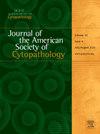Diagnostic FNA biopsies of palpable lesions without ultrasound guidance: a single-center study and narrative review of the literature
Q2 Medicine
Journal of the American Society of Cytopathology
Pub Date : 2025-01-20
DOI:10.1016/j.jasc.2025.01.004
引用次数: 0
Abstract
Introduction
Recent studies suggest that ultrasound-guided fine-needle aspiration biopsy (iFNAb) enhances diagnostic accuracy for palpable lesions. This study evaluates the efficacy of palpation-guided FNAb (pFNAb) performed at Unidade Local de Saúde de Coimbra, Portugal, compares findings to existing literature, and identifies lesions that could benefit from ultrasound guidance.
Materials and methods
A retrospective review of 278 pFNAb cases from 2021 to 2023 was conducted, collecting data on lesion characteristics, procedural details, and operator expertise. Diagnostic accuracy was determined through concordance with histopathology, flow cytometry, or clinical follow-up. Statistical analyses included Fisher’s exact test, chi-square tests, and logistic regression. A Preferred Reporting Items for Systematic reviews and Meta-Analyses-guided literature review was also performed to contextualize findings.
Results
Diagnostic accuracy was achieved in 84% of pFNAb cases. Lesions less than 1 cm exhibited significantly lower diagnostic rates compared to larger lesions. Diagnostic accuracy improved with additional needle passes, reaching 87% with 3 attempts. Anatomical location significantly influenced outcomes, with scalp lesions having the lowest diagnostic rate (33%) compared to skin and soft tissue lesions (85.7%). Literature review findings corroborated the data, emphasizing the superior accuracy of iFNAb for smaller or anatomically challenging lesions.
Conclusions
pFNAb is effective for diagnosing most palpable lesions and provides a standard of care in settings without imaging resources. However, iFNAb is recommended for specific cases, such as small or scalp lesions, to enhance diagnostic accuracy. Tailoring biopsy approaches based on lesion characteristics can improve outcomes, reduce repeat procedures, and enhance patient care.
无超声指导下可触及病变的诊断性FNA活检:一项单中心研究和文献综述。
最近的研究表明,超声引导下的细针穿刺活检(iFNAb)提高了可触及病变的诊断准确性。本研究评估了在葡萄牙科英布拉大学(universade Local de Saúde de Coimbra)进行的触诊引导FNAb (pFNAb)的疗效,将结果与现有文献进行了比较,并确定了可能受益于超声引导的病变。材料和方法:回顾性分析了2021年至2023年278例pFNAb病例,收集了病变特征、手术细节和操作人员专业知识的数据。诊断的准确性是通过组织病理学、流式细胞术或临床随访来确定的。统计分析包括Fisher精确检验、卡方检验和逻辑回归。系统综述和meta分析引导文献综述的首选报告项目也被执行,以使研究结果背景化。结果:诊断准确性达到了84%的pFNAb病例。小于1cm的病变的诊断率明显低于较大的病变。增加针道后,诊断准确率提高,3次针道后达到87%。解剖位置显著影响预后,头皮病变的诊断率最低(33%),而皮肤和软组织病变的诊断率最低(85.7%)。文献回顾结果证实了数据,强调iFNAb对较小或解剖上具有挑战性的病变具有优越的准确性。结论:pFNAb对大多数可触及病变的诊断是有效的,并在没有影像学资源的情况下提供了标准的护理。然而,iFNAb推荐用于特定病例,如小或头皮病变,以提高诊断准确性。根据病变特征定制活检方法可以改善结果,减少重复手术,并加强患者护理。
本文章由计算机程序翻译,如有差异,请以英文原文为准。
求助全文
约1分钟内获得全文
求助全文
来源期刊

Journal of the American Society of Cytopathology
Medicine-Pathology and Forensic Medicine
CiteScore
4.30
自引率
0.00%
发文量
226
审稿时长
40 days
 求助内容:
求助内容: 应助结果提醒方式:
应助结果提醒方式:


